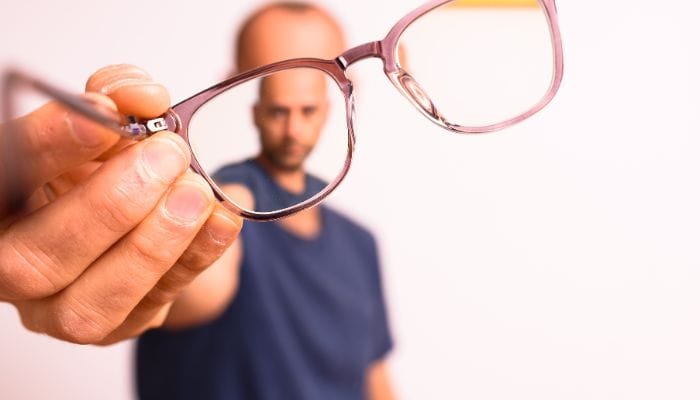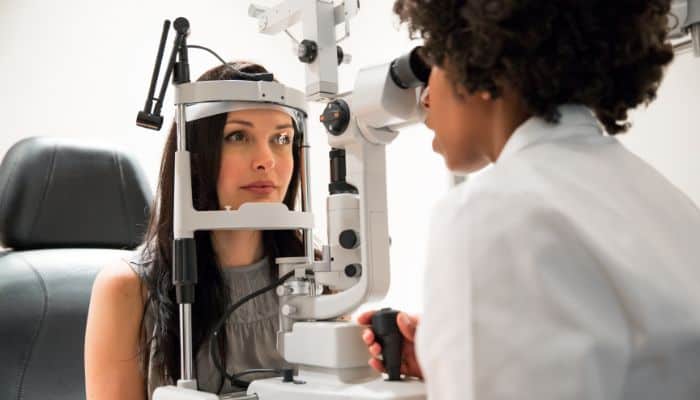No one likes getting a headache, but can prescription glasses actually be the source of your problem?
In this post, we’ll explore why you might be experiencing headaches while wearing glasses and how you can find relief if so.
Are Prescription Glasses Causing Your Headaches?
It’s certainly possible for prescription glasses to cause headaches or a feeling of dizziness.
If you recently got a new prescription, it might take some time for your eyes to adjust.
Additionally, eye strain from prolonged use of digital devices or reading can also lead to a headache.
Here are the main culprits:
A New Prescription (Especially If Drastically Different)

You may experience headaches if you just got new glasses for the first time, or a new prescription that’s significantly changed.
When you switch to a new prescription, your eyes and brain sometimes need time to adapt to the changes.
During this adaptation period, you may experience symptoms such as blurriness, dizziness, and even mild headaches.
However, when the prescription is drastically different, your symptoms can be more pronounced.
Here’s why a drastic change in prescription strength can lead to headaches:
- Increased strain: Your eyes have to work harder to focus through new lenses, which can lead to increased strain on the eye muscles. This is because your eyes and brain need time to adjust to your new prescription strength.
- Visual distortion: Drastic changes in prescription can cause visual distortion, such as blurring or double vision, which can trigger a headache.
- Sensory overload: Your brain is constantly receiving new visual information with a drastically different prescription, leading to sensory overload.
Eye Strain

If you experience frequent headaches, eye strain may be the culprit.
Eye strain occurs when your eyes become fatigued from intense use, such as staring at a computer screen for long periods without a break.
It can cause a range of symptoms, including dry eyes, blurred vision, and headaches.
Prolonged screen time, reading in low light, and improper use of prescription glasses can all contribute to eye strain.
Multifocal Lenses

While multifocal lenses can provide clear vision at different distances, they can also present some challenges leading to tension headaches.
Here are three common issues when wearing progressive or multifocal glasses:
- Adjusting to different visual zones: Multifocal lenses have specific zones for near, intermediate, and distance vision. It takes time for your eyes to learn how to switch between these zones, which can cause strain and discomfort initially.
- Finding the right angle: Depending on the design, you may need to tilt your head or adjust your gaze to find the clearest focus. Progressive lenses in particular have a narrow “sweet spot” for each distance vision. If you’re not looking through the lens at the correct angle, your vision may be blurry or distorted. Constantly searching for the right angle can strain your eye muscles and cause headaches.
- Navigating stairs or uneven surfaces: Progressive lenses can also significantly affect depth perception, making it more challenging to judge distances accurately. This can be particularly problematic when navigating stairs or uneven surfaces.
Crooked Or Poor-Fitting Glasses

Having a pair of crooked or ill-fitting glasses can cause headaches and discomfort.
When your glasses don’t fit properly, they can create pressure points on your nose or behind your ears.
Additionally, glasses that constantly slide down your nose or sit crookedly can cause you to strain your eyes in order to maintain clear vision.
This extra effort can result in eye fatigue, which can manifest as headaches.
Incorrect Prescription

You may unknowingly be wearing the wrong prescription for your vision. It’s unfortunate, but it can happen.
Here are some possibilities why you might be wearing the wrong prescription:
- Inaccurate eye exam: If your eye exam isn’t conducted properly or if the measurements are incorrect, you may end up with glasses that don’t match your actual visual correction needs.
- Lab errors: Mistakes can happen during the lens manufacturing process, resulting in glasses with the wrong prescription.
- Old prescription: If you’re still wearing glasses with an outdated prescription, they’re no longer suitable for your current visual needs.
Wearing the wrong or outdated prescription glasses can lead to a range of symptoms, including blurred vision, vertigo, and eye discomfort.
Prolonged use of the wrong prescription can even worsen vision problems, so don’t delay in getting your eyes checked.
Tips For Preventing Headaches
Don’t Focus On The Same Viewing Distance For Too Long (AKA the 20-20-20 Rule)

Make sure to take breaks if you work at a computer by looking at different distances every so often.
The 20-20-20 rule is a simple yet effective way to give your eyes a break and reduce the strain caused by extended screen time.
By looking at something 20 feet away for at least 20 seconds every 20 minutes, you allow your eye muscles to relax and prevent them from becoming fatigued.
Here are three practical tips for incorporating this rule into your daily routine:
- Set reminders on your phone or computer to alert you every 20 minutes.
- Associate the 20-20-20 rule with other habits, such as taking a sip of water or stretching your legs.
- Use apps or browser extensions that provide visual cues or reminders to take breaks.
Get Anti-Reflective Lens Treatment

A good anti-reflective coating will go a long way towards reducing glare, minimizing eye strain, and preventing headaches.
Anti-reflective (AR) coatings reduce reflections off your lenses and allow more light to pass through.
Studies have shown that wearing lenses with AR coating can improve visual comfort and decrease eye strain.
Many people report a significant reduction in eye fatigue and improved visual acuity (clarity) with anti-reflective treatment, particularly when using a computer or driving.
Investing in a good anti-glare lens treatment can greatly enhance your visual experience and help alleviate headaches caused by eye strain.
To maintain their effectiveness, clean AR lenses with a microfiber cloth and avoid using harsh chemicals.
Use Proper Lighting

When working at a computer, position your desk lamp at the correct angle to provide adequate lighting and prevent headaches.
Here are some tips to help you create an ideal lighting environment:
- Use diffused lighting for computer work: Avoid harsh, direct light that can cause glare on your screen. Instead, opt for a desk lamp with a shade or a light source that’s positioned away from the computer screen, providing a soft, even illumination.
- Adjust screen brightness to match ambient lighting: Make sure your screen or monitor brightness is adjusted to match the lighting in the room. If the room is too bright, increase the screen brightness; if it’s too dim, decrease it. This will help reduce eye strain and minimize the risk of headaches.
- Position lights to avoid glare: Ensure that lights are positioned in such a way that they don’t create glare on reflective surfaces, such as glossy screens or shiny desks. Adjust the angle and direction to minimize glare and create a comfortable working environment.
Make Sure Your Eyeglasses Fit Properly

When wearing new glasses, be mindful of how they fit on your face and head.
A proper fit is essential because it ensures that your prescription lenses provide the proper visual correction for you.
Ill-fitting glasses can cause discomfort and uneven pressure on the sides of your head can also lead to headaches.
Fortunately, these issues can be easily resolved through adjustments made by your optician.
Your optician can make small tweaks to the frame, such as adjusting the nose pads or temples, which can make a significant difference in comfort.
It’s also important to choose the right frame size, shape, and style that suits your face.
A well-fitting frame won’t only improve comfort but also enhance the overall function of your glasses.
See Your Eye Doctor Regularly

To prevent vision-induced headaches, make an appointment with your eye doctor for a comprehensive eye exam.
Regular check-ups are important to ensure that your prescription is accurate and up-to-date.
Your vision can and does change over time, and adjustments may be needed in your lens power to alleviate strain on your eyes.
Your eye doctor is trained to detect and address underlying issues that could be causing your headaches.
If you experience any of the following symptoms, see your eye doctor sooner than your next scheduled visit:
- Frequent headaches, especially after extended periods of reading or screen time.
- Blurred or double vision
- Eye strain or fatigue, accompanied by redness or dryness.
Bottom Line
Wearing prescription glasses is supposed to help improve your life, not cause headaches. If your headaches become frequent or persistent even after adjusting the lighting or resting your eyes, don’t delay – consult your eye doctor to ensure that your glasses are in good working condition and that your prescription is accurate.